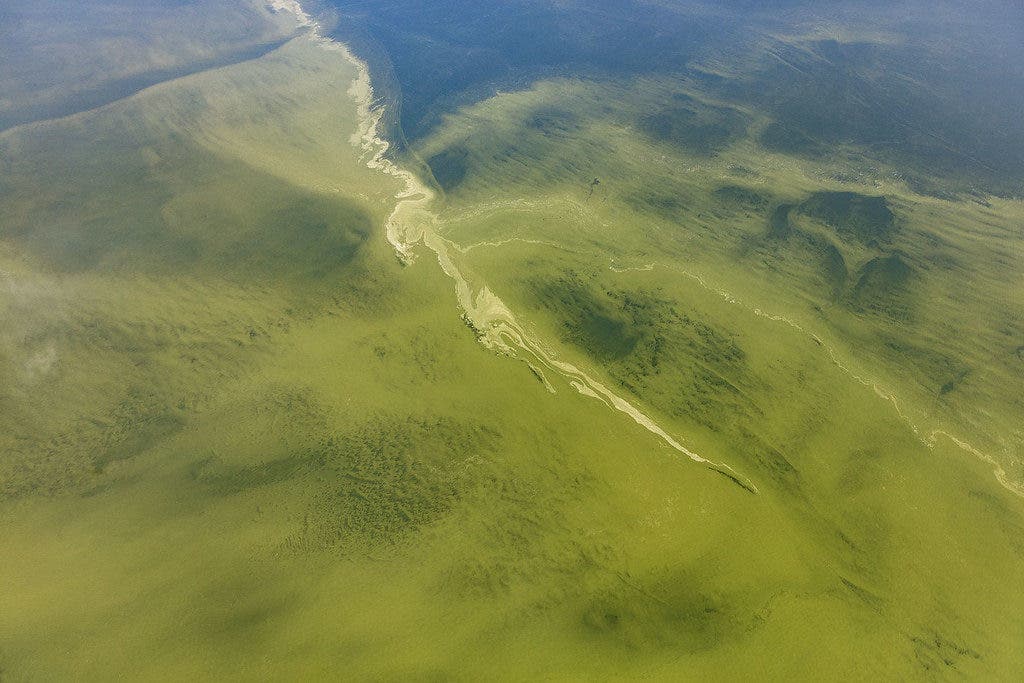The world is blooming under our stewardship — with algae. That’s bad, and it’s got a lot to do with pollution and climate heating.

Image credits Aerial Associates Photography, Inc / Zachary Haslick via NOAA Great Lakes Environmental Research Laboratory / Flickr.
Summer algal blooms in freshwater lakes have been increasing in intensity over the past three decades, a new study reports. While the exact causes of this trend aren’t yet clear, the team does note that only those lakes which experienced the least warming over this period saw improvements in algal bloom levels.
Blighting blossoms
“Toxic algal blooms affect drinking water supplies, agriculture, fishing, recreation, and tourism,” explained lead author Jeff Ho from Carnegie Mellon University. “Studies indicate that just in the United States, freshwater blooms result in the loss of $4 billion each year.”
Algal blooms are aquatic phenomena that can cause a lot of damage to bodies of water and the life they harbor either through the intensity of their growth or because they include populations of toxin-producing phytoplankton.
Reports of such blooms have been increasing in later years — such as the 2016 and 2018 blooms that led Florida to declare a state of emergency. Studies thus far have focused on freshwater algal blooms in individual lakes, specific regions, or on short timeframes. Therefore, there was no data to determine whether these blooms were getting worse, on a global scale, until this study. Likewise, the degree to which human activity (agriculture, urban development, and climate change) was contributing to this problem was undetermined.
The study looks at algal blooms in freshwater bodies over a 30-year period. The data they used was recorded by NASA and the U.S. Geological Survey’s Landsat 5 near-Earth satellite, which monitored the planet’s surface between 1984 and 2013 at a 30-meter resolution. What the team wanted to uncover were the long-term trends in summer algal blooms in 71 large lakes across 33 countries on six continents. The researchers also embarked on a partnership with Google Earth Engine to process and analyze all the data (more than 72 billion data points).
“We found that the peak intensity of summertime algal blooms increased in more than two-thirds of lakes but decreased in a statistically significant way in only six of the lakes,” Michalak explained. “This means that algal blooms really are getting more widespread and more intense, and it’s not just that we are paying more attention to them now than we were decades ago.”
While the overall trend was clear — more intense blooms — the mechanisms powering it was different from lake to lake, with no consistent patterns among the lakes where blooms have gotten worse (at least as far as factors such as fertilizer use, rainfall, or temperature are concerned).
Among the lakes that saw improvements in algal blooms over the 30-year period, only those that experienced the least warming were able to sustain these improvements. The authors say this points to climate change as a likely factor hampering lake recovery in some areas.
“This finding illustrates how important it is to identify the factors that make some lakes more susceptible to climate change,” Michalak said. “We need to develop water management strategies that better reflect the ways that local hydrological conditions are affected by a changing climate.”
The paper “Widespread global increase in intense lake phytoplankton blooms since the 1980s” has been published in the journal Nature.


